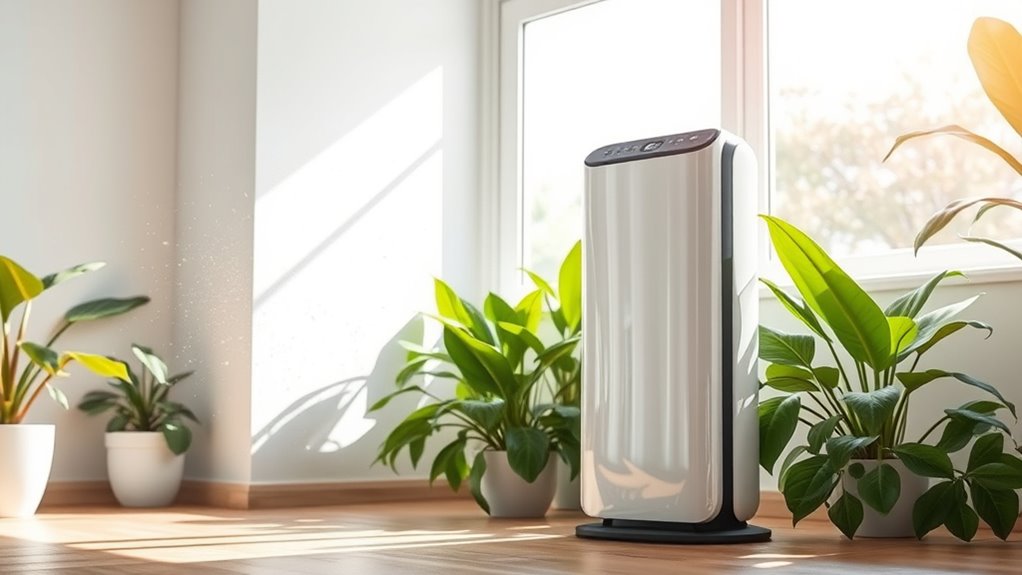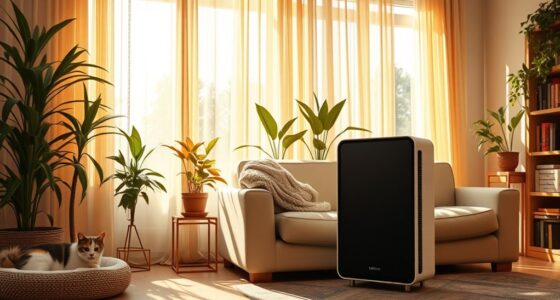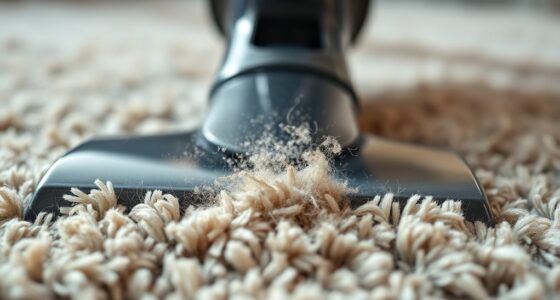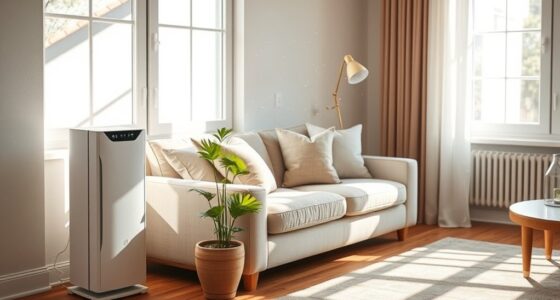Using air purifiers can greatly improve your indoor air quality by removing harmful particles, but they come with environmental challenges. HEPA filters generate non-biodegradable waste, and their production has a significant carbon footprint. Regular maintenance can help minimize waste, but recycling is complicated due to contamination and manufacturing materials. Innovative models, like microalgae-based purifiers, offer sustainable alternatives. There’s more to explore about balancing health and sustainability with air purifiers—and you might find some surprising solutions.
Key Takeaways
- Air purifiers improve indoor air quality but contribute to non-biodegradable waste from HEPA filters and other materials.
- The production and disposal of air purifiers generate a significant carbon footprint, impacting environmental sustainability.
- Recycling challenges arise from non-recyclable materials and contamination of HEPA filters, complicating waste management.
- Innovations like microalgae-based purifiers and longer-lasting filters aim to reduce environmental impact and enhance sustainability.
- Regular maintenance and proper usage of air purifiers can extend their lifespan and mitigate their environmental footprint.
Understanding the Benefits of Air Purifiers for Indoor Air Quality
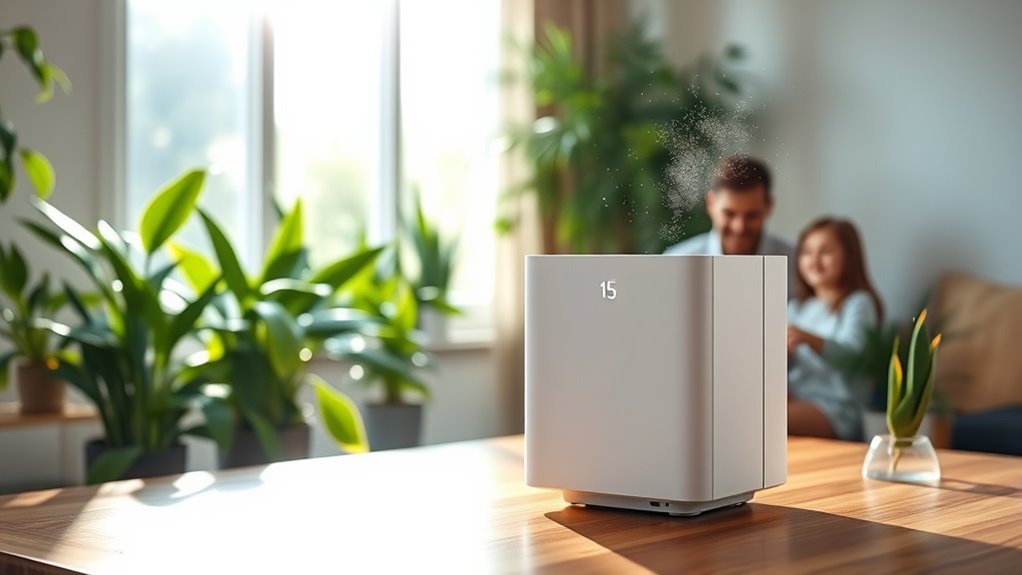
How can air purifiers transform your indoor air quality? By effectively removing harmful particles like PM2.5, air purifiers can greatly improve indoor air quality.
Studies reveal that indoor PM2.5 levels can be 5-10 times higher than outdoor levels, posing serious health risks, including respiratory diseases and cardiovascular issues. Health authorities recommend air purifiers, especially during events like the COVID-19 pandemic, to lower exposure to airborne viruses and allergens.
Indoor PM2.5 levels can be significantly higher than outdoors, increasing health risks and emphasizing the importance of air purifiers.
With purification efficiencies ranging from 43.48% to 86.41%, these devices can dramatically enhance environmental health in your home. Combining air purifiers with natural ventilation can yield even better results, especially in summer. Additionally, many models utilize multi-functionality features that include air ionization and aroma diffusion for added benefits.
In winter, relying solely on air purifiers is the best method for effective PM2.5 removal, ensuring cleaner air for you and your family. Moreover, many air purifiers utilize HEPA filters to capture up to 99.97% of airborne particles, further improving indoor air quality.
The Environmental Footprint of Air Purifiers
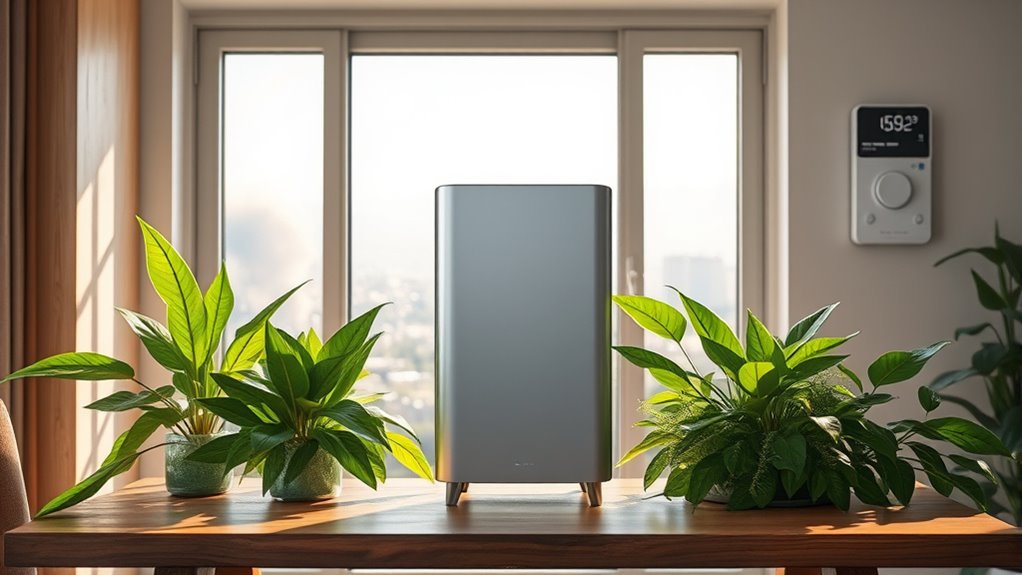
HEPA air filters, which need replacement every 6 to 12 months, generate significant non-biodegradable waste, adding to landfill overflow. In addition, the carbon footprint associated with producing, transporting, and disposing of air purifiers and their filters heightens their environmental impact. Regular maintenance and proper filter replacement can help mitigate some of these concerns. Furthermore, using hydrogen fuel cells as an alternative energy source for powering air purifiers can contribute to a reduction in overall pollution. Additionally, understanding the refrigeration cycle can aid in optimizing the energy efficiency of air purifiers, ultimately reducing their environmental impact.
However, the industry is shifting towards sustainability with innovations like longer-lasting filters and microalgae-based models, which aim to minimize waste. By focusing on these advancements, you can help promote more eco-friendly air purification options and contribute to reducing waste in the long run. Moreover, choosing energy-efficient operation can help mitigate the overall environmental footprint of using air purifiers.
Recycling Challenges for Air Purifiers: What You Need to Know
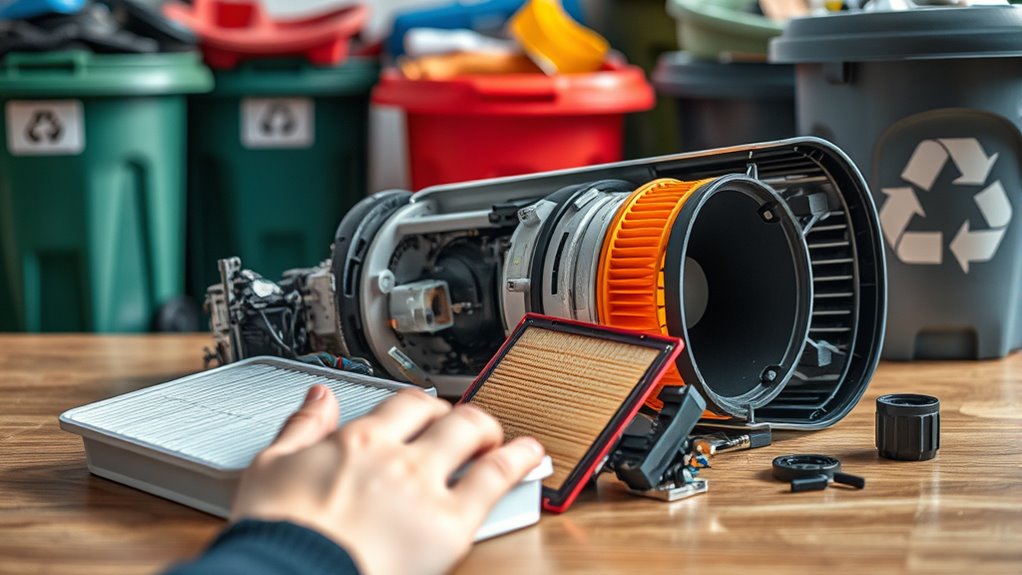
As air purifiers become more common in households, understanding their recycling challenges is essential. Many components, especially air filters like HEPA filters, are often non-recyclable due to contamination, which increases landfill waste. Additionally, essential oils can sometimes be used in air purifiers for a pleasant scent, but improper use can lead to waste and environmental impact. The varying recycling protocols across states and cities complicate the recycling process further. Furthermore, the manufacturing of air purifiers frequently uses non-recyclable materials, adding to the environmental burden during both production and disposal. The size and complexity of these devices make them difficult for recycling facilities to process alongside other electronic waste. Ongoing assessments in the air purifier industry highlight the urgent need for improved sustainability practices and innovations to enhance recyclability, ensuring that we minimize our environmental impact while enjoying cleaner air. High refresh rates in air purifiers can improve air quality more efficiently, reducing the frequency of filter replacements. Regular filter replacement guidelines are also crucial to consider, as they can influence overall waste generated from these appliances, particularly since HEPA filters typically last only 6-12 months before needing replacement. Additionally, the incorporation of high-fiber foods in our diet can significantly aid in reducing waste and promoting health, paralleling the need for sustainable practices in air purifier usage.
Sustainable Practices in Air Purifier Manufacturing
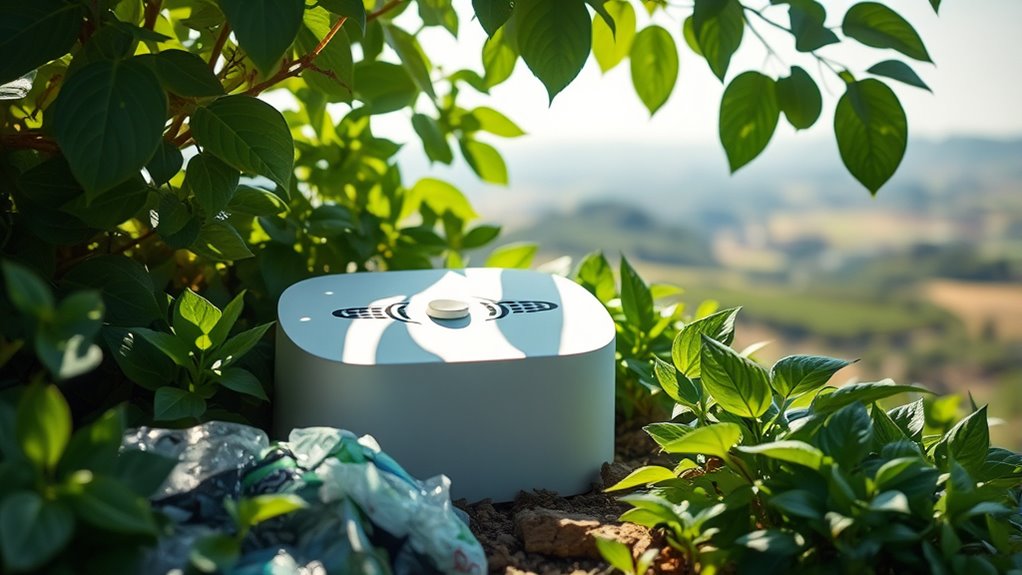
Recycling challenges highlight the need for sustainable solutions in air purifier manufacturing.
Manufacturers are stepping up by embracing sustainable practices to reduce their environmental footprint. Here’s how they’re doing it:
- Local sourcing: Parts are increasingly sourced locally, minimizing carbon emissions from shipping.
- Microalgae-based air purifiers: These innovative designs convert pollutants into biostimulants, promoting a circular ecological cycle. Additionally, these systems often incorporate energy-efficient models, which can reduce energy consumption significantly. Furthermore, manufacturers are taking inspiration from plants, utilizing natural air purifiers that can enhance indoor air quality.
- Focus on longevity: High-quality air purifiers are built to last, reducing waste from frequent replacements. Additionally, analytics cookies can help manufacturers track user engagement and preferences, leading to more informed product development. Moreover, continuous learning among manufacturers fosters innovation in sustainable practices.
Ongoing environmental assessments are essential for improving recyclability, as many components are tough to recycle. Additionally, companies are exploring cost-effective solutions to enhance the sustainability of their product offerings.
By prioritizing sustainability, the industry aims to balance health protection with ecological responsibility.
You can support these efforts by choosing air purifiers that reflect these sustainable innovations.
Balancing Health and Environmental Responsibility With Air Purifiers
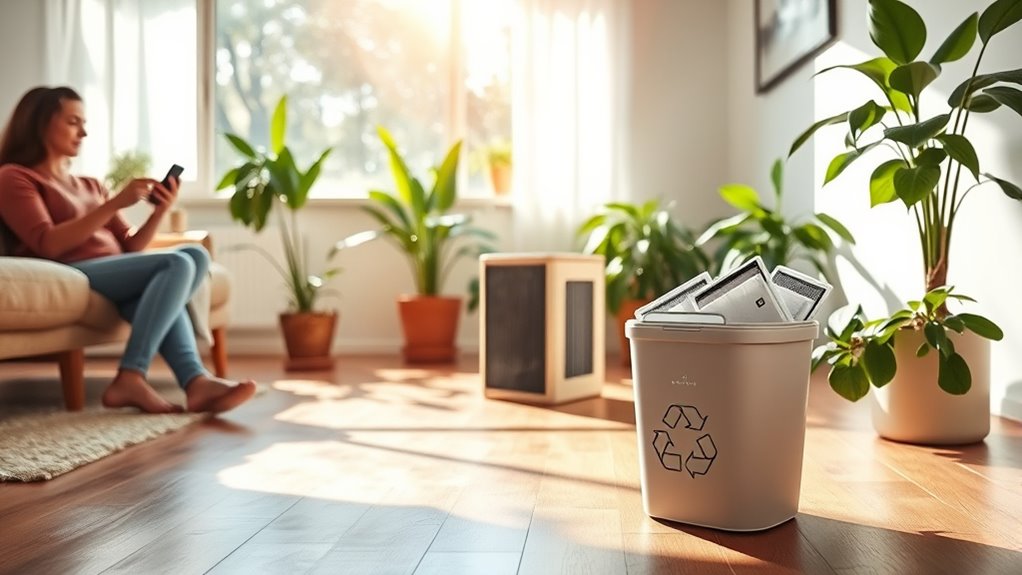
Air purifiers play an essential role in improving indoor air quality, yet their environmental impact can’t be overlooked. While you benefit from reduced air pollution and enhanced health outcomes, the frequent replacement of HEPA filters generates non-biodegradable waste, increasing the environmental impact of air filtration. To balance health with environmental responsibility, consider innovative, environmentally friendly alternatives like microalgae-based purifiers. These options minimize waste and transform captured pollutants into biostimulants for plants, promoting a circular ecological cycle. Additionally, implementing regular maintenance plans for your air purifiers can help extend their lifespan and reduce waste, as cleaning filters is crucial for maintaining efficiency. Regular maintenance can significantly improve the efficiency of your air purifiers, much like how geothermal systems require routine inspections to maintain optimal performance.
Furthermore, ongoing advancements in the air purification industry focus on creating longer-lasting filters and improving recyclability. By choosing sustainable options, you can enjoy the positive impact of clean air without compromising the planet’s health. Furthermore, integrating heat pumps into your home’s climate control system can enhance energy efficiency and lower your carbon footprint while maintaining a comfortable environment.
Frequently Asked Questions
What Is the Negative Effect of Air Purification?
You mightn’t realize that air purification systems can have negative effects.
They often require regular filter replacements, which create a lot of non-biodegradable waste. If you use low-quality filters, they can clog quickly, leading to more frequent disposal.
This not only contributes to landfill overflow but also increases carbon emissions from manufacturing and transport.
Is There a Downside to Air Purifiers?
Yes, there’s a downside to air purifiers. They can generate waste, especially if you’re using filters that need regular replacement.
If you don’t maintain your purifier, you might end up with poor air quality instead of the clean air you expect.
Plus, some models may not be effective against all pollutants, leaving you exposed to harmful particles.
It’s essential to choose wisely and stay on top of maintenance to avoid these issues.
Are There Health Concerns With Air Purifiers?
Using air purifiers can feel like breathing fresh mountain air in your home, but there are health concerns to take into account. Some models emit ozone, which can worsen respiratory issues, so you’ll want to choose wisely.
If you neglect filter maintenance, you might end up worsening air quality instead of improving it. Regularly replacing filters is essential for your health, ensuring that you truly benefit from cleaner indoor air without harmful side effects.
Is an Air Purifier Eco-Friendly?
When you consider whether an air purifier’s eco-friendly, it’s crucial to look at its design and materials.
Some models use non-recyclable components, adding to waste. However, newer purifiers with microalgae technology show promise for sustainability. They can repurpose pollutants into plant nutrients.
If you choose a high-quality model and maintain it well, you can extend its life, reducing overall waste.
Ultimately, it depends on the specific purifier you select.
Conclusion
In summary, while air purifiers can greatly improve indoor air quality—reducing pollutants by up to 99%—it’s essential to take into account their environmental impact. Many purifiers contain non-recyclable components that contribute to landfill waste. By choosing models from manufacturers committed to sustainable practices, you can enjoy cleaner air without compromising the planet. Remember, your health and environmental responsibility can go hand in hand, making a positive impact on both your home and the world around you.
